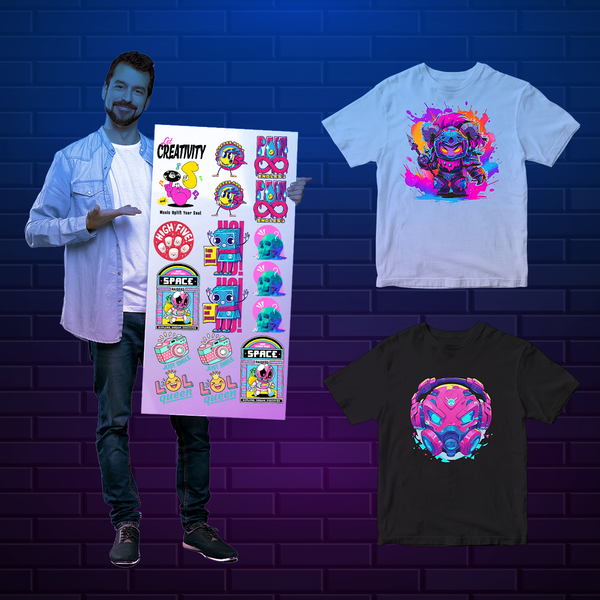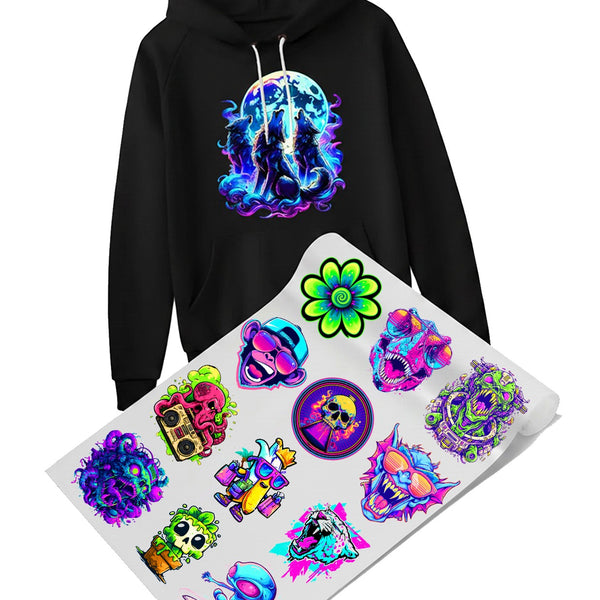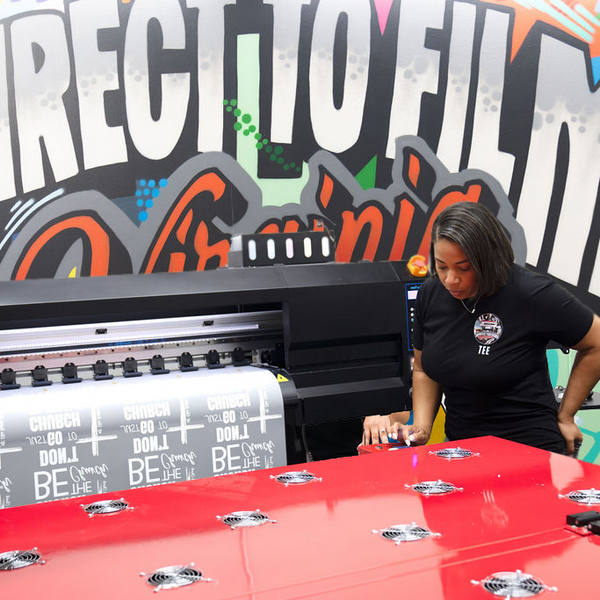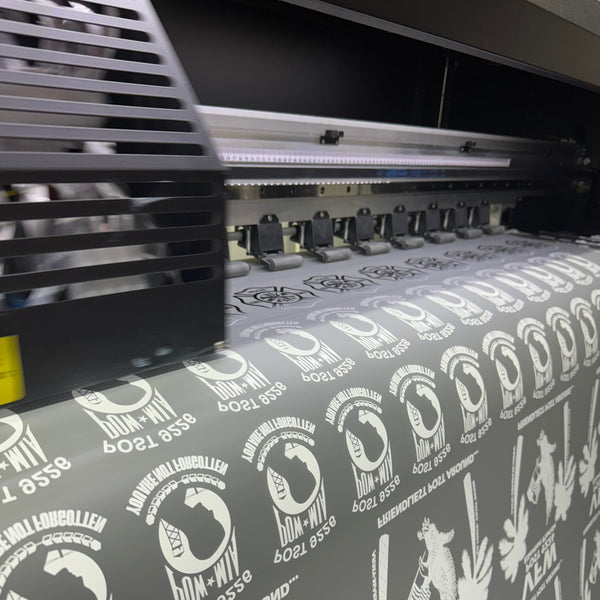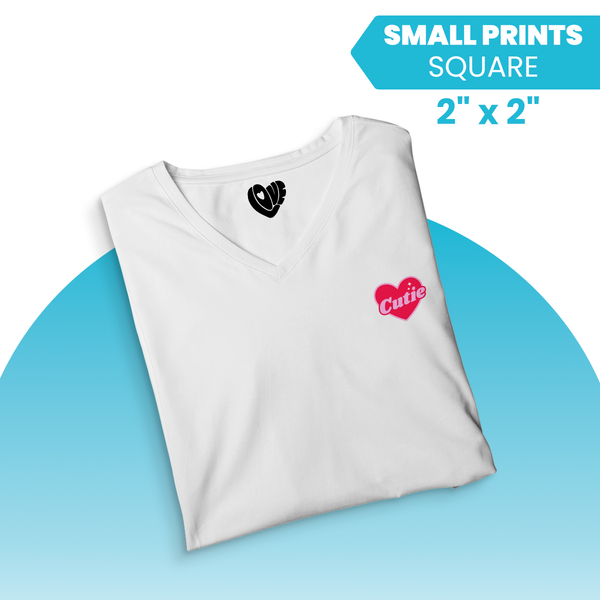So, you've been hearing a lot about custom apparel lately, right? Maybe you're dreaming of starting your own t-shirt line with vibrant designs. Or perhaps you just want some cool, personalized gear for a special occasion like Father's Day or for your team's long sleeve shirts. If that sounds like you, then understanding dtftransfers is going to be a game-changer, potentially simplifying how you approach printing on various types of blank apparel. These things are taking the custom printing scene by storm, and for good reason, as you'll soon see how dtftransfers can elevate your projects.
It's a very active time in garment decoration. New methods appear, but some truly stand out from the pack, like dtf transfers. This is definitely the case here, making things easier and more vibrant than ever before for creating custom apparel.
What Exactly Are DTF Transfers?
First off, DTF stands for Direct to Film. Imagine your fantastic design gets printed onto a special film using advanced dtf printing techniques. Then, this film, carrying your design, is used to transfer dtf artwork onto your chosen fabric. It's a relatively simple concept, but the technology involved is quite smart, producing results that are both durable and striking.
Unlike some other printing methods, these dtf printed transfers are very versatile. We're talking about successful applications on dtf on cotton, polyester, blends, leather, and even those tricky dark-colored fabrics which often pose challenges for other methods. This flexibility opens up so many possibilities for your creative ideas, from detailed dtf logo printing to full-scale graphics. You're not limited by fabric type as much as with techniques like sublimation printing, for instance, which primarily works on light-colored polyester.
The dtf heat transfer process is distinct because the design is fully formed on the film first, then applied, rather than printing directly onto the garment. This means you can achieve full color dtf transfers with excellent detail. The feel of dtf transfers for sale can vary, but generally, they offer a softer hand than older transfer types, especially after the first wash.
The Magic Behind DTF Printing: How It Works
From Screen to Film: Digital Design Preparation
You might be wondering how these designs actually make it from a computer screen onto a shirt through the dtf printing transfers process. The procedure for creating dtftransfers is quite interesting. It all begins with your digital design, which you might prepare as part of a larger dtf gang sheet to maximize efficiency.
Printing on PET Film with DTF Inks
First, a special DTF printer, loaded with specific DTF inks (Cyan, Magenta, Yellow, Black, and White), prints your design in reverse on a transparent PET film; this is known as dtf film printing. This film is not just any plastic; it's treated to hold and then release the ink perfectly during the dtf transfer printing stage. The white ink layer is crucial because it acts as a base, making colors pop and appear true, especially important for dtf printing on cotton and dark garments, and achieving that vibrant dtf color.
Applying Adhesive Powder
Once the design is printed on the film, an adhesive powder is applied carefully. This fine, white powder
sticks only to the wet ink of your print dtf design. Any extra powder is shaken off, so it does not interfere
with the final look of your dtf transfers. Think of it like adding a very precise, functional coating.
Curing the Transfer
Next, the film with the ink and powder goes through a curing process. This usually involves a specialized heating oven or sometimes the heat tunnel function of a larger, integrated machine. The heat melts the powder, turning it into an adhesive glue layer that will bond to the fabric. After curing, your dtf transfers are ready for pressing dtf transfers onto almost any fabric or can be stored for later use, offering great flexibility for your dtf order fulfillment.
Heat Press Application
Finally, to apply the design, you place the film on the garment and use one of the many available heat presses. The heat and pressure activate that adhesive layer, bonding the ink to the fabric. After a few seconds, you peel off the film, and your vibrant, durable design, possibly a custom dtf creation, is now part of the garment. This is how you successfully press dtf designs.
Why Everyone's Talking About Using DTFTransfers
Versatility Across Fabrics
So, what's all the excitement about? Why are so many people, from hobbyists working on a diy dtf transfer to established businesses, turning to dtftransfers? The benefits are quite persuasive, making them a top choice for custom apparel, promotional items, and even for those looking for dtf printing near me.
Durability of DTF Transfers
One of the biggest advantages is versatility, as touched upon earlier. These transfers work beautifully on a huge range of materials. Cotton, polyester (making dtf printing on polyester a great option), nylon, leather, treated fabrics, darks, lights – you name it, making dtf heat applications very broad. This is a massive plus because you're not restricted to just a few types of garments, unlike sublimation that typically requires polyester-rich fabrics, or some types of heat transfer vinyl which might not adhere well to all surfaces.
Vibrant Color & Print Quality
Durability is another major win when you buy dtf transfers. When applied correctly, dtf print transfers are incredibly tough. They can withstand numerous washes without cracking, peeling, or fading, outperforming some traditional print transfers. This means your custom creations, like those made from a dtf gang of designs, will look great for a long time, which is exactly what you want, right?
No Pre-Treatment Needed
Let's talk about print quality; dtf in printing truly shines here. DTF delivers stunningly vibrant colors and can reproduce very fine details and intricate designs, essential for detailed dtf logo printing. Because a white ink base is used, colors stay true and bright even on the darkest shirts, leading to fantastic full color dtf transfers. Photos, complex graphics, tiny text – dtftransfers can handle it all with impressive clarity, making them some of the best dtf transfers available.
Comfortable Feel on Garments
A huge practical benefit is that most fabrics do not need any pre-treatment, which can be a common requirement for other methods. Some printing techniques, like Direct to Garment (DTG), often need a chemical pre-treatment solution sprayed onto the garment before printing. This adds an extra step, cost, and sometimes affects the feel of the fabric. With dtftransfers, you can often skip this step entirely, saving time, hassle, and improving the efficiency of making dtf transfers.
Business Benefits & Cost Effectiveness
The feel of the print, often called the "hand," is also very good. While not as completely weightless as sublimation transfers (which dye the fabric fibers), DTF prints are generally softer and more flexible than older traditional transfers or some types of thick transfer vinyl like siser glitter. This makes the garments more comfortable to wear, an important factor for everyday apparel.
Environmentally Friendly Options
For businesses, cost-effectiveness and scalability are important, especially when ordering dtf transfers. DTF printing can be very cost-effective, especially for small to medium-sized orders, and you can often find cheap dtf transfers when ordering in bulk or using gang sheets. You do not have the extensive setup costs of screen printing (like making screens for each color). This makes it great for custom dtf transfers, one-offs, or limited runs. As your needs grow, the process can also scale up; a provider from a dtf transferzone can often handle large quantities.
Reduced Waste & Gang Sheet Efficiency
Some argue there are also some environmental plus points. Because it is a transfer process, there's generally less ink waste than some direct printing methods. Also, many DTF inks are water-based, which can be a more environmentally conscious choice compared to solvent-based inks used in some other printing technologies. Many suppliers also offer options to combine multiple designs on gang sheets combine multiple designs efficiently, reducing film waste. For example, you could get information on dtf gang sheets to see how to maximize your print area.
Getting Started with DTF Transfers: What You Need
Printing Transfers Yourself
Alright, you're interested. You see the potential in dtf transfer what is it and how it works. So, what do you actually need to start working with dtftransfers? It depends if you want to print dtf transfers yourself or buy them ready-made from services offering dtf transfers near me. If you're thinking of printing dtf transfers yourself, especially for a small business or serious hobby, you'll need some specific gear. At the heart of it is a DTF printer, specially designed for printing on dtf film. These printers are specially designed to handle the films and DTF inks. You'll also need RIP software (Raster Image Processor), which is crucial for managing dtf color accuracy, white ink layers, and overall print quality.
Equipment & Consumables
Of course, you'll need consumables: DTF inks (Cyan, Magenta, Yellow, Black, and White), special PET films, and the hot-melt adhesive powder. Don't forget a way to cure the powder; this could be a small curing oven, a heat tunnel, or even a heat press with precise temperature control that can hover without contact. And finally, you'll need a good quality heat press, essential for actually applying the finished transfer dtf to your garments. A reliable heat press gives you even temperature and pressure, which are fundamental for a lasting dtf heat transfer.
Ordering Ready-Made Transfers
But what if you don't want to invest in all that equipment right away for your dtf order? That is perfectly fine. Many people choose to buy dtf transfers from a print service or find the best place to buy dtf transfers online. You simply provide your design, perhaps as a custom gang sheet, and they print the transfers for you. This is a great option if you're just starting out, have occasional needs, or prefer to focus on design and sales rather than production. You might even find suppliers offering free shipping on larger orders.
Choosing a Reliable Supplier
If you go this route for ordering dtf transfers, look for a supplier that offers good quality, uses reliable materials, and has good customer reviews. Ask about their turnaround times for dtf transfers for sale and how they can help you optimize your artwork for a dtf gang sheet if needed. Getting samples can also be a good idea to assess the quality of their dtf printed products before committing to a large order. Searching for "dtf transfer printing near me" can yield local options, while online vendors offer a wide selection.
Applying Your DTF Transfers Like a Pro

Prepping the Garment
Once you have your dtftransfers, either printed yourself or ordered from a place that offers dtf printing near me, applying them is the next step. Getting this part right is crucial for a professional-looking and durable result when pressing dtf transfers. Do not worry, it is not too complicated.
First, prepare your garment, perhaps some blank apparel like a t-shirt or a long sleeve top. Make sure it's clean and wrinkle-free. It is a good idea to pre-press the garment for about 5-10 seconds. This removes any moisture and smooths out the application area for the dtf transfer on cotton or polyester.
Heat Press Settings
Heat press settings are vital. Generally, for dtftransfers, you'll be looking at temperatures between 280°F to 320°F (around 140°C to 160°C). The pressing time is usually 10-15 seconds, with medium pressure. These settings ensure the dtf heat is optimal for adhesion.
These settings can vary slightly based on your specific film, powder, and the fabric you're using. Always check the recommendations from your dtf transfers supplier or equipment manufacturer. It is smart to test on a scrap piece of fabric first if you can, especially if it's a new type of dtf transfer or fabric.
Placing the Transfer
Next, carefully position your DTF transfer on the garment, design side down (so the adhesive side is touching the fabric). You can use heat-resistant tape to hold it in place if you're worried about it shifting, which is helpful for precise dtf logo printing. Make sure it is straight and exactly where you want it. Cover the transfer with a Teflon sheet or parchment paper to protect your heat press and the transfer.
Pressing and Peeling
Now, press dtf. Close the heat press and apply according to your set time, temperature, and pressure. Once the time is up, open the press carefully. The next step is peeling the film. This is where dtftransfers can be either "cold peel" or "hot peel" (or sometimes warm peel). "Cold peel" means you let the transfer cool down completely before removing the film. "Hot peel" means you remove it immediately while it is still hot.
Follow the instructions for your specific custom dtf transfers. Peeling at the wrong temperature can mess up the print. Peel slowly and steadily. For an extra smooth finish and improved durability, some people like to do a second press for about 5-7 seconds after peeling, again using a Teflon sheet or parchment paper for protection. This helps to really set the ink into the fabric fibers of your dtf printed item.
Parameter General Range Notes
Temperature 280°F - 320°F (140°C - 160°C) Varies by film/powder/fabric. Check supplier guidelines. Time 10-15 seconds (first press) 5-7 seconds (optional second press after peeling). Pressure Medium Consistent pressure from your heat press is key. Peel Type Cold or Hot Follow supplier instructions for your specific dtf transfers. And there you have it. A perfectly applied DTF design. With practice, applying dtf print transfers becomes a quick and efficient process.
Troubleshooting Common DTF Transfer Issues
Even with the best intentions, sometimes things do not go perfectly when working with dtftransfers. If you run into issues with your dtf transfer printing, do not panic. Here are a few common problems and how you might fix them.
Transfer Not Sticking Properly
Is the transfer not sticking properly or peeling up at the edges after you press dtf? This is often due to incorrect temperature, pressure, or pressing time on your heat presses. Double-check your settings. Make sure your press is delivering even pressure. Sometimes, old adhesive powder or very textured fabrics can also cause adhesion issues with dtf heat transfer applications.
Dull or Faded Colors
Do your colors look dull or not as vibrant as you expected from your full color dtf transfers? This could be an issue with the original artwork file quality or incorrect dtf color profiles. Or, if printing dtf transfers yourself, it might be printer settings, incorrect ink levels, or the quality of your inks or film. Using a white underbase correctly is crucial for vibrancy on dark garments and achieving good dtf on cotton or polyester.
Cracking After Washing
Is the transfer cracking after just a few washes? This usually points back to application when pressing dtf transfers. The transfer might not have been cured properly on the film during the making dtf transfers stage, or it was not pressed onto the garment with the right heat, time, or pressure. An insufficient second press, if recommended for your type of dtf transfer, can also be a factor. Always confirm a good bond between the ink and fabric.
Adhesive Residue Around the Design
Do you see a faint outline of powder or adhesive residue around your design on your dtf printed item? This means excess powder was not fully removed before curing the transfer. Or, the curing temperature might have been too high, causing the powder to melt beyond the inked area. Be thorough when shaking off excess powder before the curing stage of dtf film printing.
Dye Migration on Polyester
Another issue, especially with dtf printing on polyester, can be dye migration. This is where dye from the fabric bleeds into the transfer, discoloring lighter areas of the print. Using dye-blocking transfers or specific low-bleed powders can help prevent this when working with problematic fabrics. Addressing these usually involves carefully reviewing each step of your process, from design preparation to final pressing. Small adjustments can make a big difference to your dtf transfers.
Caring for Your DTF Decorated Garments
You've put in the effort to create or apply these awesome dtftransfers. So, you will want them to last. Proper care is simple but makes a big difference for the longevity of your dtf print transfers.
For washing, it is best to turn the garment inside out. This protects the dtf printed design from abrasion with other clothes in the wash. Use cold or cool water and a mild laundry detergent. Harsh detergents or bleach can damage the print over time, affecting the vibrancy of the dtf color.
When it comes to drying, tumble drying on a low heat setting is usually fine for garments with dtf transfers. But, to be extra safe and extend the life of the print even more, hang drying or laying it flat to dry is the best option. High heat from a dryer can sometimes affect the adhesive or the print itself over many cycles, especially for intricate custom dtf designs.
If you need to iron the garment, never iron directly over the DTF transfer. Iron around it, or turn the garment inside out and iron on the reverse side on a low heat setting. Putting a cloth over the print area while ironing can also offer protection. By following these simple care steps, your dtftransfers, including any dtf screen print transfers if that term is used for a similar aesthetic, will keep looking great for a long, long time.
DTF Transfers vs. Other Decoration Methods: A Quick Look
It helps to see how dtftransfers stack up against other popular ways to decorate apparel like screen printing dtf or using siser easy color vinyl. Each method has its strengths. Understanding the differences can help you choose the best one for your project, whether you're making stock transfers or highly customized pieces.
| Method | Pros | Cons | Best For |
|---|---|---|---|
| DTF Transfers | - Works on many fabrics (cotton, polyester, blends) - Durable and vibrant full-color prints - Fine details without pre-treatment - Ideal for small/medium runs - Great for custom, on-demand prints | - Slight "hand-feel" compared to sublimation - Initial investment in equipment if doing DIY production | Full-color designs on varied fabrics, complex graphics, and on-demand DTF gang sheet printing |
| DTG (Direct to Garment) | - Very soft hand-feel - Excellent for complex, photorealistic color prints - Uses water-based inks | - Best for cotton or blends only - Often needs pre-treatment on dark garments - White ink can be costly - Slower for large batches | Photorealistic designs on cotton, soft-feel finishes, small batch production |
| Screen Printing | - Extremely durable - Cost-effective for high volumes - Vibrant colors - Special effect inks available | - High setup cost per design/color - Not ideal for small orders - Less detail than DTF printing transfers | Large volume orders, simple logos or graphics with limited colors |
| Sublimation Transfers | - No hand-feel - Very vibrant and permanent prints - Excellent for polyester - Ideal for all-over printing | - Works only on light-colored polyester or poly-coated items - Not suitable for cotton or dark fabrics | Sportswear, full-coverage prints on light-colored polyester |
| Heat Transfer Vinyl (HTV) | - Great for simple designs, numbers, or text - Available in different finishes (glitter, metallic, etc.) - Budget-friendly for one-offs | - Can feel bulky - Complex designs require time-consuming weeding - Limited to solid colors (not great for full-color images) | Names, numbers, logos, one-off customizations, and layered vinyl designs |
As you can see, dtftransfers offer a very compelling mix of quality, versatility, and ease of use that fills a significant spot in the market. They bridge the gap between different methods quite nicely, making them a go-to for many who buy dtf transfers or seek dtf transfers near me. Some might even consider uv dtf for hard goods, which is a similar film-based transfer technology but for different applications beyond textiles.
The Future of Custom Apparel with DTFTransfers
The popularity of dtftransfers is not just a fleeting trend; it is a significant development dtf in printing. It seems they are here to stay and will likely play an even bigger role in custom apparel and product decoration in the future. The technology for dtf printing transfers is constantly improving, making it more accessible and efficient for everyone from individuals looking for a diy dtf transfer solution to large businesses fulfilling a complex dtf order.
We are seeing advancements in printers, inks, and films all the time. This means better quality for dtf printed goods, faster production speeds, and potentially lower costs for those ordering dtf transfers. For small businesses and entrepreneurs, this is fantastic news as it lowers the barrier to entry for creating high-quality custom products and finding the best place to buy dtf transfers becomes easier.
The ability to print dtf on demand without massive setup changes is huge. It allows for more personalization and customization than ever before. Imagine easily creating unique items for specific events, groups, or individual customer requests using custom dtf designs. DTF technology helps make this a practical reality, especially with the efficiency of using a dtf gang sheet builder. It is truly shaping how we approach customized goods, and many a dtf transferzone or print shop is adopting this method rapidly.
Conclusion
Well, there you have it. A pretty good look into the exciting developments with dtftransfers. From understanding dtf transfer what is it and how dtf printing works, to seeing their benefits and how to use them for dtf transfer on cotton or other materials, I hope this helps you feel more informed. The custom printing field is always moving, but dtftransfers definitely offer a powerful and versatile solution for many creative projects, whether you're searching for "dtf near me" or considering setting up your own operation for making dtf transfers.
Whether you need cheap dtf transfers for a large promotional run or the best dtf transfers for high-end retail products, this technology offers a compelling option. As you explore dtf transfers for sale or look into dtf printing near me, remember the versatility and quality that dtf transfers bring to the table. It's a great time to get involved with dtf print transfers and bring your designs to life.







